Papua New Guinea Provinces
SOUTHERN HIGHLANDS
PROVINCE
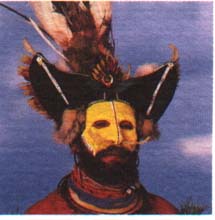 In the centre of Papua
New Guinea is the Southern Highlands Province,
called "The Papuan Wonderland"
by explorers who discovered these hidden
mountain valleys in 1935. In the centre of Papua
New Guinea is the Southern Highlands Province,
called "The Papuan Wonderland"
by explorers who discovered these hidden
mountain valleys in 1935.
The Southern Highlands is a land of lush,
high valleys wedged between impressive limestone
peaks. The headwaters of the Kikori, Erave
and Strickland rivers cross the province,
beneath towering Mr Giluwe, the second highest
mountain in Papua New Guinea. International
caving expeditions have discovered caves
of enormous depth and length and anticipate
further significant finds in areas yet to
be explored.
This cool alpine setting is the home of
the Huli and Duna Wigmen. Famous for their
elaborate and colourful dress, these proud
warriors have great reverence for birds,
imitating them in ceremonial dances and
decorating their wigs with feathers, flowers
and cuscus fur. The wigs, are woven from
human hair, donated by wives and children.
Everlasting daisies are especially cultivated
for use in the wigs, while their faces are
painted with yellow and ochre. The women,
by contrast wear black for their wedding
and coat themselves with blue-grey clay
when mourning.
Clans in the Southern Highlands have a
strong and intricate social system little
affected by change. It is one of the few
places where the traditional way of life
can be seen in everyday living. Ceremonial
rituals are strongly observed. Men and women
can still be seen wearing traditional dress,
tending their gardens and pigs and building
their bush material huts. Visitors to the
tribal wonderland of the Southern Highlands
can stay in a variety of accommodation from
basic guest houses to luxurious mountain
lodges.
Accommodation at the Ambua Lodge in the
Tari Basin is in luxury bush material huts,
set on a hillside of flowering gardens with
panoramic views of the surrounding mountains
and rainforest. The crisp mountain air is
perfect for taking advantage of the many
guided tours organised by The Lodge. Walk
along rainforest tracks to go bird watching,
take a trip down the river to see the waterfalls
or go by four wheel drive to visit a village
and watch a traditional singsing.
South of Mendi, the capital of the Province,
is Lake Kutubu. The beauty of this tranquil
setting can be enjoyed from the Lake Kutubu,
situated on a ridge overlooking the lake.
The Lodge, built by the local people to
allow visitors to observe traditional life
in comfortable surroundings is constructed
of bush materials. Butterflies and Birds
of Paradise are common in this area. The
Lodge will arrange tours to some of the
beautiful rivers and waterfalls nearby.
Warm clothes and wet weather gear are recommended
for visits to the Highlands and, particularly
for women, conservative dress would be considered
more appropriate, ie. long skirts rather
than shorts and a sarong over a swimsuit
when swimming.
Map of Southern
Highlands
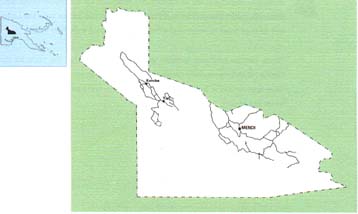
WESTERN
PROVINCE
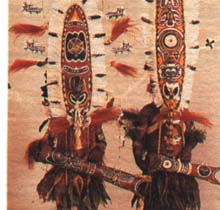 Western Province, on
the southern coast, bordering Irian Jaya,
is a perfect destination for fishermen,
photographers and lovers of flora and fauna.
The countryside here is unlike anywhere
else in Papua New Guinea. Wide open grasslands
are home to Rusa deer, wallabies and wild
pigs. Crocodiles, and lizards linger near
river banks and teems of wild fowl and ducks
fly across rivers. Two of the greatest rivers
in the country, the Fly and the Strickland,
run for almost their entire length through
Western Province. Western Province, on
the southern coast, bordering Irian Jaya,
is a perfect destination for fishermen,
photographers and lovers of flora and fauna.
The countryside here is unlike anywhere
else in Papua New Guinea. Wide open grasslands
are home to Rusa deer, wallabies and wild
pigs. Crocodiles, and lizards linger near
river banks and teems of wild fowl and ducks
fly across rivers. Two of the greatest rivers
in the country, the Fly and the Strickland,
run for almost their entire length through
Western Province.
The premier tourist destination in Western
Province is Bensbach Wildlife Lodge, located
on the Bensbach River. The mouth of the
river forms the border between Papua New
Guinea and Irian Jaya. The area is a vast
open, seasonally flooded plain, lightly
populated with people, but crowded with
bird and animal life. The Bensbach Lodge,
small, comfortable and built of local materials,
has established a reputation for spectacular
barramundi fishing. Other species include
ox eye herring and saratoga. Fresh locally
caught fish and game are part of the regular
menu.
Lake Murray, in the centre of the province,
is the biggest like in Papua New Guinea.
There is crocodile research station at the
lake. During the wet season the lake spreads
to five times its 400 kilometre area.
Western Province is home to the giant Ok
Tedi gold and copper mine, one of the largest
mines in the world. Established in 1980
in rugged mountainous terrain, the mining
operation processes 80,000 tonnes of ore
each day.
Daru, the main town of the Province is
situated on a small island of the same name
just off the coast. Once a busy pearl and
beche-de-mer trading port, it is now the
centre of a growing fishing industry. Crocodile
skins from the province are packed and exported
from Daru.
Air Niugini offers direct flights from
Port Moresby to Daru while third level airlines
service most parts of Western Province.
Map of Western
Province
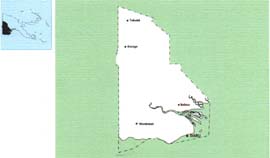
WEST
NEW BRITAIN PROVINCE
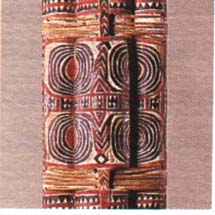 In contrast to the popular
tourist destination of East New Britain,
West New Britain is virtually untouched,
unexplored and unknown. The exception is
Walindi Plantation Dive Resort, a favourite
destination for divers from all parts of
the world. In contrast to the popular
tourist destination of East New Britain,
West New Britain is virtually untouched,
unexplored and unknown. The exception is
Walindi Plantation Dive Resort, a favourite
destination for divers from all parts of
the world.
The Resort is located on a privately owned
oil palm plantation on the shores of Kimbe
Bay. The Bay is fringed by volcanic mountains,
some still active. Divers can explore volcanic
caves draped in staghorn coral and reef
drop-offs. The clear blue waters are home
to dogtooth tuna, trevally, barracuda, dolphins
and dugong and for night diving, the luminescene
lights the way. The most popular site for
night diving is known as "The Cathedral",
a horse shoe shaped reef with a large cave
at one end. The floor is covered in white
sand and the outside is draped in staghorn
and gorgonia coral. Walindi has resident
instructors to provide tuition for first
time divers. The fishing and snorkelling
are excellent.
Non-divers can enjoy the superb natural
surroundings. The Muruk cave system in the
Nakanai area of West New Britain is believed
to be the deepest recorded in the southern
hemisphere. A French cave expedition team
recently explored the system and believe
there is a canyon about 1,200 metres below
the entrance of the cave.
The pretty little town of Talasea looks
across the bay with its many islands from
Williamez Peninsula, an active volcanic
region. Talasea is a centre for the manufacture
of shell money. It was from this area that
obsidian, volcanic glass used in the manufacture
of knives, spears and arrows used for trade
from about 3,000BC until recent times, was
found. In the hills behind Talasea are the
wrecks of two US bombers, one of them a
B24 Liberator.
On Pangula Island, across from Talasea
is the Valley of Wabua, meaning "Valley
of Hot Water", a mass of thermal geysers.
Apart from Walindi Resort there are several
other options for accommodation including
the Palm Lodge in the provincial headquarters
of Kimbe; the Hoskins Hotel in the small
town of Hoskins where the main airport for
West New Britain is located; the Kautaga
Guest Haus on a small island off the western
side of the peninsular and the Bialla Guest
House.
Air Niugini and a number of third level
airlines fly via Hoskins airport from other
parts of Papua New Guinea every day. There
are also a number of coastal ships which
call in at Kimbe on their way to and from
Lae and Rabaul.
Map of West New Britain
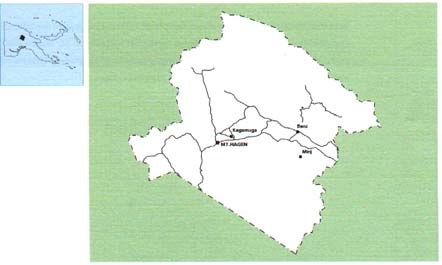
WESTERN
HIGHLANDS PROVINCE
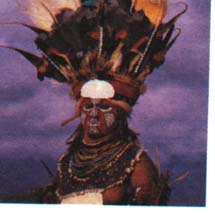 From the lowland rainforest,
to alpine grasslands, to the shrouded misty
peaks, Western Highlands Province is a land
of colour and vibrancy. The capital city,
Mt Hagen, is a bustling commercial centre
where wealth from coffee and tea plantations
has brought rapid change to traditional
life style. Old and new ways live curiously
together, not always harmoniously. Mt Hagen
has a reputation as the "wild frontier"
of the Highlands. From the lowland rainforest,
to alpine grasslands, to the shrouded misty
peaks, Western Highlands Province is a land
of colour and vibrancy. The capital city,
Mt Hagen, is a bustling commercial centre
where wealth from coffee and tea plantations
has brought rapid change to traditional
life style. Old and new ways live curiously
together, not always harmoniously. Mt Hagen
has a reputation as the "wild frontier"
of the Highlands.
The Saturday market in Mt Hagen is a focal
point of local life and provides a meeting
place for traders from all over the province.
It is a kaleidoscope of fruit and vegetables,
birds, animals, people in bright shirts
and skirts, some wearing flowers or grass
in their hair. The men traditionally wear
a long beard and the women wear an array
of brilliant scarves and carry their brightly
coloured string bags. These bags, called
bilums, are used to carry everthing from
babies to firewood and are made by treading
an entire length of string through each
loop. Traditionally the string is made from
tree bark, although these days many women
buy synthetic yarn from the local stores
for their bilums. The Mt Hagen market is
an opportune place to purchase tradionally
made bilums.
Handicrafts can also be found at the Western
Highlands Cultural Centre in Mt Hagen. It
features a reconstructed village hut and
has a museum with exhibits of artefacts
and curios.
Singsings are held regularly throughout
the province. These are gatherings of clans
in traditional costume where ritualistic
dancing and singing is perfomed for ceremonial
reasons. However there are many opportunities
throughout the year to watch a ceremonial
singsing. The most popular time to visit
Mt Hagen is August when the annual show
is held. Hundreds of different Highland
tribes are represented, each wearing their
distinctive tribal head dresses of feathers
and flowers and body paint. It is a wonderful
opportunity to se a glimpse of the richness
of traditional Highlands social structure.
Away from Mt Hagen, Western Highlands Province
offers spectacular walking and trekking
adventures. The Wahgi Valley is a magnificent
natural tract of lush greens, roaring rivers,
virgin rainforest and ordered gardens. Ther
are several walks available depending on
time and energy. For the serious trekker,
the 4509 metre summit of Mt Wilhelm can
also be reached from Mt Hagen.
Accommodations in Mt Hagen ranges from
bush material lodges to international standard
hotels. Air Niugini has flights from Port
Moresby to Mt. Hagen daily and direct flights
are available from Cairns, Australia to
Mt Hagen. Third level airlines also provide
services from other regional centres.
Map of Western
Highlands
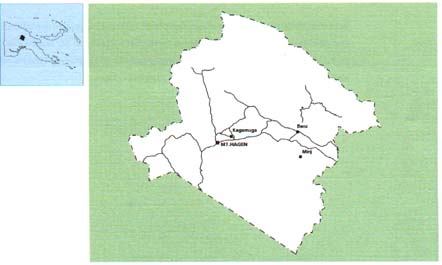
|